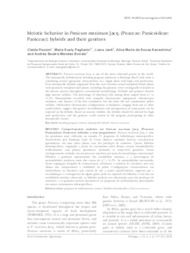Meiotic behavior in Panicum maximum Jacq. (Poaceae: Panicoideae: Paniceae): hybrids and their genitors.
Meiotic behavior in Panicum maximum Jacq. (Poaceae: Panicoideae: Paniceae): hybrids and their genitors.
Author(s): JANK, L.
Summary: Panicum maximum Jacq. is one of the most cultivated grasses in the world. The intraspecific hybridization breeding program underway at Embrapa Beef Cattle aims at combining several agronomic characteristics in a single plant with high seed production. Four intraspecific hybrids originated from the cross between sexual tetraploid female plants with apomictic tetraploid male plants, including the genitors, were cytologically evaluated in the meiotic process throughout conventional methodology. Hybrids and genitors showed high meiotic stability. The percentage of abnormal cells among them ranged from 6.7 to 14.2%. Abnormalities recorded were irregular chromosome segregation, chromosome stickiness, and absence of the first cytokinesis, but the latter did not compromise pollen viability. Multivalent chromosome configurations at diakinesis, ranging from one to three quadrivalents, suggest that genetic recombination and introgression of some genes can be expected in the hybrids. Based on meiotic stability, the hybrids should be selected for high seed production, and the genitors could remain in the program participating in other intraspecific crosses.
Publication year: 2010
Types of publication: Journal article
Unit: Embrapa Beef Cattle
Observation
Some of Embrapa's publications are published as ePub files. To read them, use or download one of the following free software options to your computer or mobile device. Android: Google Play Books; IOS: iBooks; Windows and Linux: Calibre.
Access other publications
Access the Agricultural Research Database (BDPA) to consult Embrapa's full library collection and records.
Visit Embrapa Bookstore to purchase books and other publications sold by Embrapa.

